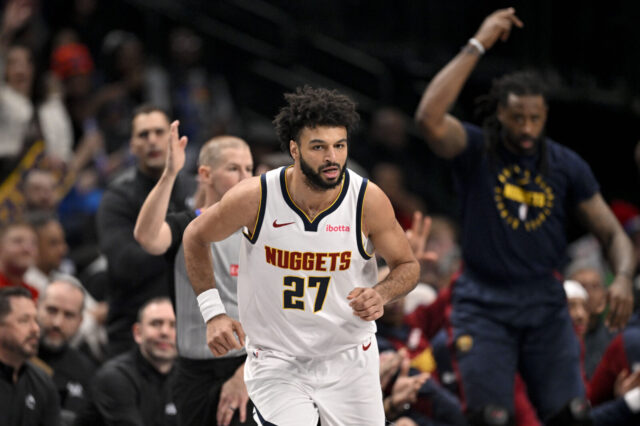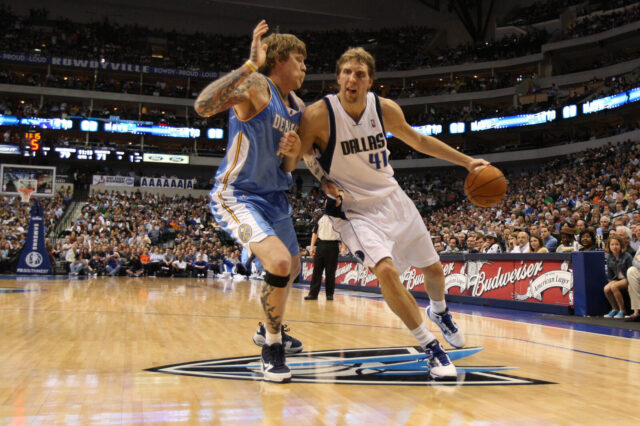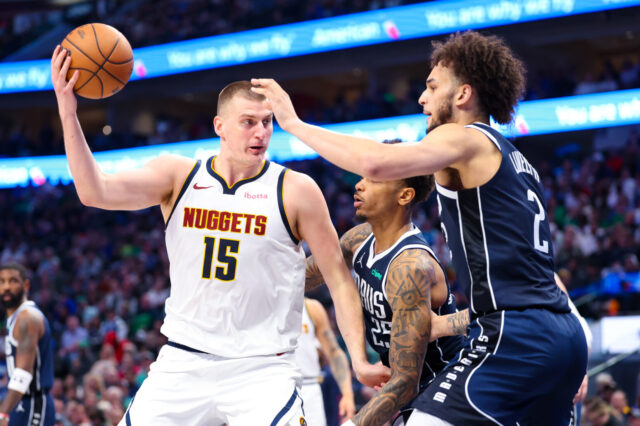This content is no longer available.
This content is no longer available.
The discussion around backup point guard for the Denver Nuggets last offseason centered around free agent signee Isaiah Thomas. Coming off of a difficult year split between the Cleveland Cavaliers and Los Angeles Lakers, Thomas sat out the majority of the 2017-18 season recovering from separate hip surgeries, and it wasn’t clear when he would return to full strength in the Mile High City.
As it turns out, his presence on the floor wan’t really necessary. Monte Morris and his expected leap ensured that.
After playing just 25 minutes during his rookie season, Morris entered Summer League in Las Vegas looking to prove to the Nuggets that he could be a full-time rotation member. He put a lot of minds at ease during the summer, and when the regular season hit, Morris immediately provided stability to the bench unit. He played in all 82 games this year, starting six of them, and operated as the steadying hand behind the erratic yet explosive offense of Jamal Murray. This tandem helped Denver win a lot of games, and Morris’ foundational point guard skills were a major factor.
The ball in his hands
It was no question, especially early in the season, that the bench unit was Monte Morris’ group. From the way he operated pick and roll to the unit personifying his best characteristics as a whole, the bench was simply better with Monte Morris at his best.
As a scorer in the half court, Morris’ primary weapons of choice were the spot up three, the pull-up midrange jumper, and the paint floater. His shot distribution is unique, as very few players use all three levels to score quite like Morris does.
Let’s start with the floater, a lethal weapon in development.
Morris knew he had to develop an aspect of his game that would allow him to stick in the NBA. As an undersized point guard with under-the-rim athleticism (just two dunks in 1,970 minutes played) Morris needed a way to operate efficiently approaching the paint without taking exorbitant amounts of contact at the rim from players with 50+ pounds on him. The floater is generally a difficult shot because it’s hard to gauge distance and accuracy while moving at quick speed out of the pick and roll, but Morris has mastered the touch by taking shots in distinct locations around the paint.
This content is no longer available.
This content is no longer available.
As Morris gets below the free throw line and approaches the dotted circle in the paint, he rises up to attempt a right handed floater, using his left hand as a quick guide to steady the shot.
Statistically, Morris shoots a high percentage with his floater game, going 76 of 136 (55.9%) during the regular season on normal and driving floaters. This was a great mark, especially when compared to some of the other top guards in the NBA.
This content is no longer available.
The key factor in Morris’ floater is his ability to get squared up to the rim without contorting his body. The control and fluidity he displays to get to this point and rise up for the shot in a single motion is impressive.
When Morris is operated the DHO or pick and roll game with Mason Plumlee, his floater has become so dangerous that a good screen from Plumlee forces the opposing big man to jump up and stop Morris from hitting an open shot. At that point though, it’s “pick your poison” time, because Morris is incredible at throwing the lob.
When Morris is operating with Jokic, the Serbian center generally popped to the three point line or the free throw line extended out of the pick and roll. Morris did a great job of drawing the defense on these possessions allowing Jokic free rein to hit open jump shots.
The pull up jumper was mixed in on shots where Morris felt the pressure to generate a consistent bucket, and he shot it efficiently. He hit 61 of 134 pull up jumpers in the regular season, a high percentage for another midrange basket.
Overall, Morris is a unique scorer. He doesn’t get all the way to the restricted area a ton, and he generally takes spot up threes only when they are open. He utilizes the midrange a lot, which would generally be the death of efficiency for him, but he made it work. Among the 91 players to attempt 250+ shots from 4 to 22 feet (outside of the restricted area and inside the three point line), Morris was 3rd out of 91 players in efficiency, shooting 160 of 318 overall (50.3%). The only players above him were Kevin Durant, noted midrange assassin, and Al Horford.
Monte Morris: king of the midrange among guards in 2018-19.
More versatile than advertised
What surprised many Nuggets fans wasn’t Morris’ ability to run the point. He did that at Iowa State for four years and set an NCAA record for Assist to Turnover ratio. What at least surprised me was his versatility. His defense against opposing guards, while affected by his size, was outstanding for what he could physically provide. His ability to stay in front of bench point guards was a major reason the Nuggets bench defense improved this season.
With Morris on the floor, the Nuggets posted a 104.3 defensive rating, according to the NBA website. This was the best number among Nuggets rotation players barely edging out Gary Harris (104.7) and Paul Millsap (104.8).
With Morris off the floor, the Nuggets posted a 107.4 defensive rating, a respectable number but showing moderate drop off. Jamal Murray didn’t display the same caliber of defense Morris did throughout the year, and that’s one of the biggest reasons for the difference in Defensive Real Plus-Minus. Morris finished with a +0.02 D-RPM this year which ranked 27th among point guards , while Murray finished with a -1.18 D-RPM that ranked 77th.
This content is no longer available.
He also attacked passing lanes well, positioning himself where offensive players generally find the next pass and making himself a threat to steal the ball.
Generally known for his ball control offensively, Morris was able to operate without the ball in the half court, aided by an improving jump shot. This regular season, Morris hit 41.4% of his threes, primarily as a spot up shooter. During his 171 spot up possessions, Morris averaged 1.14 PPP, good for the 85th percentile in the entire NBA and higher than noted snipers Klay Thompson. Joe Harris, and JJ Redick. This was a major reason why Denver’s bench offense was so good and also why they struggled so much in the playoffs, as Morris shot 0 of 13 from three in the postseason.
Where do the Nuggets and Morris go from here?
After his breakout season, the Nuggets have to be feeling pretty good about the contract extension Morris signed the previous summer. Because of that deal, Morris has two more years on his contract at about $1.6 million each season. This is one of the best bargains in the NBA, and a great asset for Denver financially in order to build a championship team.
Morris proved he could be one of the best sixth man candidates in the regular season from a value perspective, but he struggled during the playoffs. Averaging a 40.9 True Shooting % in Denver’s 14 playoff games killed his offensive value. Both San Antonio and Portland were comfortable guarding him in the half court, and the few times Morris was left open, he couldn’t capitalize. I would chalk his struggles up to first time playoff experience, but it’s something to watch for an undersized point guard. The playoffs tend to gravitate toward switchable lineups, as the guards get bigger and the bigs get smaller. For Morris at 175 pounds, facing off against Maurice Harkless and his 6’9, 220 pound frame was difficult. It took him out of his rhythm and he struggled to respond.
But the Nuggets have to be happy with how Morris responded to the immediate pressure to be productive given Isaiah Thomas’ long injury recovery. They found a backup point guard with the 51st pick of 2017 that’s now one of the best in the league. Among all bench players (70 games played, under 20 games started) Morris was 3rd in the NBA in win shares, behind only Montrezl Harrell and Domantas Sabonis. He contributed to winning on a highly competitive playoff team in just his second season.
It’s possible that Morris will want to start games at some point. Some may even argue that Morris was the better player between him and Jamal Murray this season. Murray is Denver’s second potential star, though, and it’s unlikely Denver would bench Murray to start Morris at this point. For right now, Denver’s point guard rotation of Murray and Morris is set for the present and future. Both players are capable next to Nikola Jokic, versatile enough to play together, and are still developing and getting better.
It’s hard to know what Morris could eventually become. His game reminds many of a star in Chris Paul, but his draft and talent profile stands out as closer to Fred VanVleet. If Morris continued to mimic VanVleet’s career though, he could be a key member of an NBA Finals team. VanVleet basically lifted the Toronto Raptors over the favored Milwaukee Bucks on the strength of his improved three-point shooting, and his defense in the NBA Finals has been great. If Morris turned into that player long term, that’s a win for the Denver Nuggets.
Time will tell what Morris’ ultimate role will be. For now, the future looks bright with him at sixth man.
This content is no longer available.


